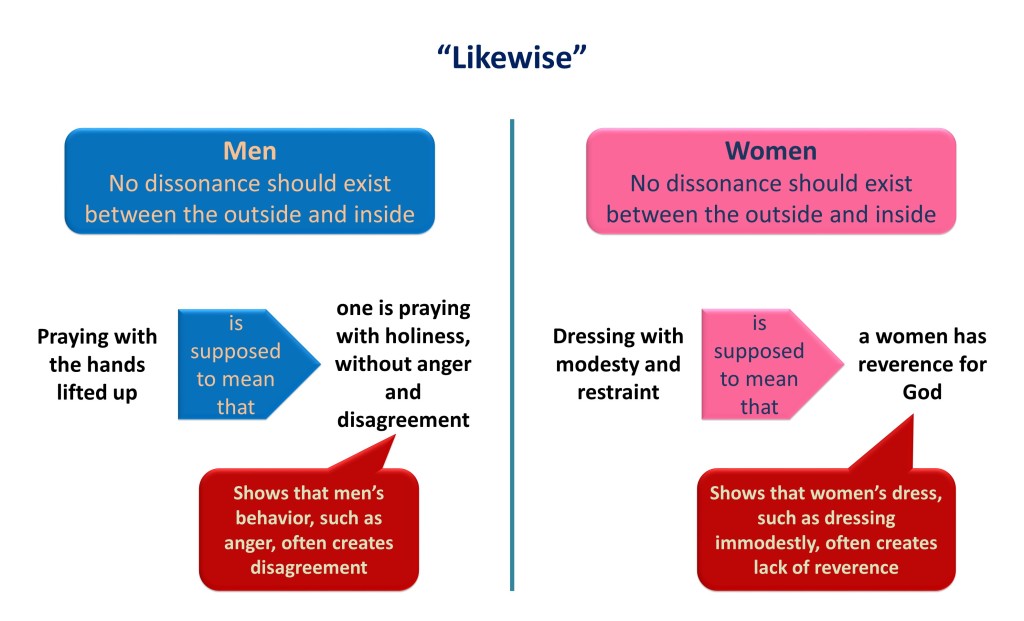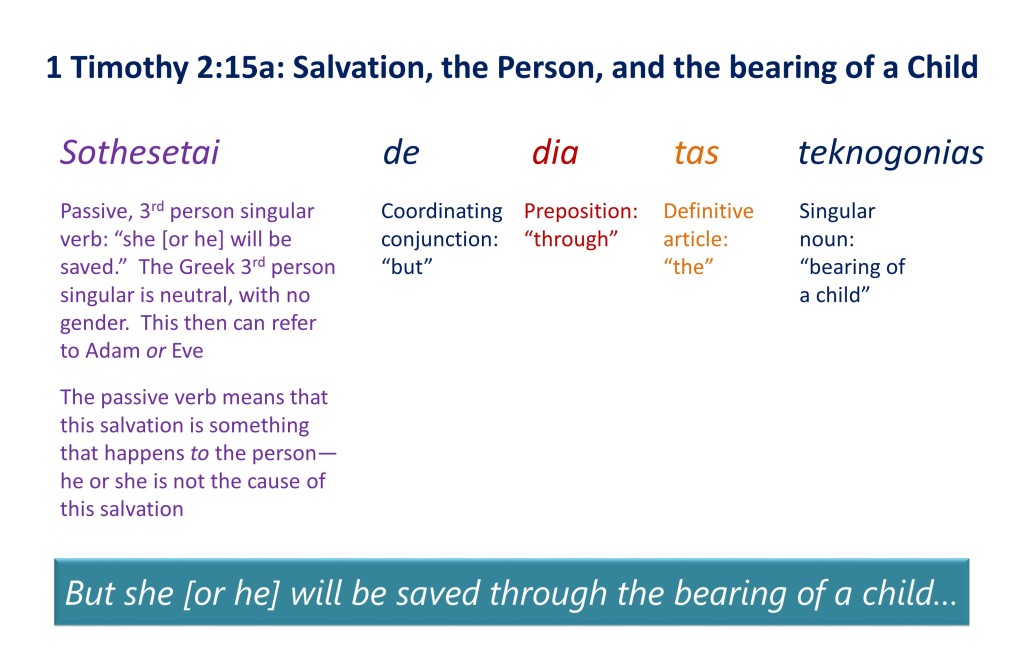 Having shared with Timothy the proper content and purpose of prayer during worship (2:1-7), Paul now discusses the proper role of men and women during worship (2:8-10), which then segues into the topic on women teaching (2:11-15). In the beginning of chapter 2, what Paul said about prayer was his request (2:1). Now his words change from request (parakaleo) to more something more directive (boulomai).
Having shared with Timothy the proper content and purpose of prayer during worship (2:1-7), Paul now discusses the proper role of men and women during worship (2:8-10), which then segues into the topic on women teaching (2:11-15). In the beginning of chapter 2, what Paul said about prayer was his request (2:1). Now his words change from request (parakaleo) to more something more directive (boulomai).
Men and women in worship
Read 1 Timothy 2:8
Paul begins with “therefore” (oun), connecting this section to the previous one. Paul now goes into how such supplications, prayer, intercessions, and thankgivings are to be made.
“in every place”: Paul echoes the fulfillment of the Old Covenant from Prophet Malachi:
“From where the sun rises to where it sets my name will be great among the Gentiles. Incense and pure offerings will be offered in my name in every place, for my name will be great among the nations,” says the Lord Almighty. [Malachi 1:11]
- Paul contrasts men leading worship (prayer) with women not leading worship (learning quietly).
 From this context, what is the proper prayer posture for men leading worship?
From this context, what is the proper prayer posture for men leading worship?
“lifting holy hands”: This was a practice the New-Covenant Church inherited from the Old Covenant. “May my prayer be set before you as incense, the lifting up of my hands like the evening sacrifice” (Psalm 141:2). “When you lift up your hands in prayer…” (Isaiah 1:15).
Artwork discovered in the Roman catacombs show that this prayer posture was the practice of the New-Covenant Church from the beginning. Writings from the early Church also testify to this practice. “You stretched out your hands to Almighty God, imploring him to be merciful…” (Clement 2:3, 96 AD). Barnabas stated that such a prayer posture confessed to placing one’s trust in God:
Standing high above them all, Moses stretched out his hands, and so Israel was again victorious. But whenever he lowered them, the men began to be killed. Why so? So that they might learn that they cannot be saved unless they place their hope in him. [Barnabas 12:2-3, after 70 AD but before 132 AD]
That is why your pastor prays using this posture during the formal prayers in worship.
- What is supposed to coincide with the lifting of the hands?
Read 2 Timothy 2:9-10
- How does Paul say that women should dress during worship? Why?
- That Paul mentions behavior for men and dress for women testifies to what, generally, about the differences between men and women?
- What does this mean about unity and reverence during worship?
- If one is to admire a woman based on what she does, what should she be admired for?
Read 1 Timothy 2:11-12
- Paul is still dealing with the context of worship. During worship, what should women do?
- What should women not do?
- How would women teach, have authority over men, or not be quiet during worship?
Paul is not forbidding women from all speech during worship, just speech in a way that exercises “authority over a man.” This passage is similar to 1 Corinthians 14:34-35 (Sunday School Lesson on this), which also deals with congregational worship. In Corinth, Paul allowed women to pray (as members of the congregation) and even to prophesy, provided they were veiled. When it came to teaching, Paul spoke positively of Priscilla (a woman) and Aquila privately teaching Apollos (Acts 18:26).
So, Paul’s prohibitions for women do not apply to all areas of life. The context of this passage and 1 Corinthians shows that these prohibitions for women only apply to the public role of teaching in the Church and leading worship. The question is why? That is what Paul explains next.
Read 1 Timothy 2:13-14
- What event in history does Paul point to as the reason for these prohibitions against women?
- If these prohibitions go back to humanity’s fall into sin, what does that say about these prohibitions as being “cultural,” only something for Paul’s day?
Read 1 Timothy 2:15a
- In context, who is the “she” or the “he” who will be saved? (2:13-14).
- Which child (remember it’s a singular in the Greek), by being born in the future, will save Adam or Eve?
Read 1 Timothy 2: 15b
Paul now switches to “they,” applying the truth of being saved, which is a passive event for the one being saved, to the present, describing what happens to “them” who remain, or do not remain, in the faith.
- Can salvation be lost? Discuss based on the text.
- Do men or women “save” themselves by continuing in faith, love, and holiness, with self-control?
Women, and men, do not save themselves by remaining in faith, love, holiness, with self-control. After all, salvation is something done to the person (remember the passive verb). Instead, one loses salvation if one chooses not to remain in faith, which happens by choosing to walk away from it. Salvation is passive; losing salvation is not.
Click here to go to the next Lesson.




